
Manduca hannibal is a moth of the family Sphingidae.

Manduca florestan, the Florestan sphinx, is a moth of the family Sphingidae. The species was first described by Caspar Stoll in 1782.
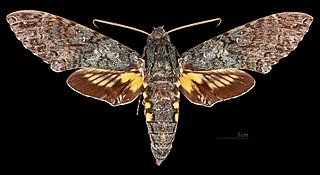
Amphonyx duponchel, or Duponchel's sphinx, is a moth of the family Sphingidae. The species was first described by Felipe Poey in 1832.

Manduca muscosa, the muscosa sphinx, is a moth of the family Sphingidae.
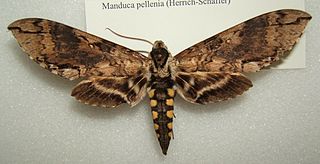
Manduca pellenia is a moth of the family Sphingidae. It is known from Mexico, Belize, Guatemala, Nicaragua, Costa Rica, Panama, Colombia and Ecuador.

Aellopos clavipes, also known as the clavipes sphinx, is a moth of the family Sphingidae.

Enyo lugubris, the mournful sphinx, is a moth of the family Sphingidae. It is found from Argentina and Paraguay to Uruguay, Venezuela, Guyana, Suriname, French Guiana, Colombia, Ecuador, Peru, Brazil and the West Indies through Belize, Guatemala, Honduras, El Salvador, Nicaragua, Costa Rica and Panama to Mexico and the United States, where it has been recorded from Arizona east to Florida and north to South Carolina. Strays have been recorded from Arkansas, north to Illinois, Michigan and New York.

Eumorpha vitis, known as the vine sphinx, is a moth of the family Sphingidae.

Manduca afflicta is a moth of the family Sphingidae known from Cuba and the Bahamas. It is similar to Manduca sexta. Adults feed on nectar from flowers. The larvae have been recorded feeding on Cestrum diurnum, the day-blooming jessamine, a member of the family Solanaceae.
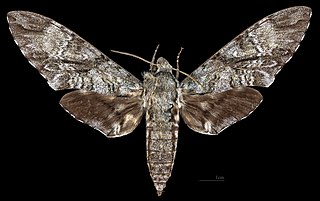
Manduca barnesi is a moth of the family Sphingidae.

Manduca dalica is a moth of the family Sphingidae.

Manduca dilucida is a moth of the family Sphingidae first described by William Henry Edwards in 1887.
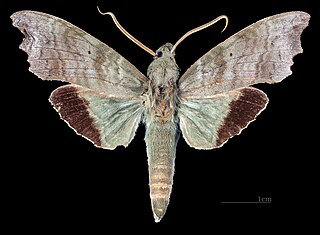
Aleuron chloroptera is a moth of the family Sphingidae. It was described by Maximilian Perty in 1833, and is known from southern Mexico, Brazil, Belize, Guatemala, Nicaragua, Costa Rica, Colombia, Peru, Bolivia, Venezuela, Guyana, Suriname, French Guiana, Paraguay, Argentina and Ecuador. It is probably also present in Uruguay, Honduras, El Salvador and Panama.

Callionima parce, the parce sphinx moth, is a species of moth in the family Sphingidae.It was originally described by Johan Christian Fabricius in 1775.

Eupyrrhoglossum sagra, the Cuban sphinx, is a moth of the family Sphingidae. The species was first described by Felipe Poey in 1832. It is known from tropical and subtropical lowlands in Cuba and from Mexico and Belize to Guatemala, Costa Rica, Bolivia, Paraguay, Argentina and Uruguay. Occasionally, strays are found in Florida.
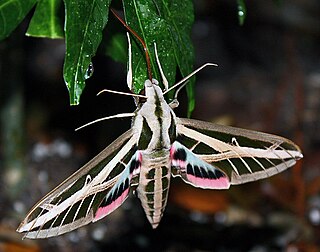
Eumorpha fasciatus, the banded sphinx, is a moth of the family Sphingidae. The species was first described by Johann Heinrich Sulzer in 1776.
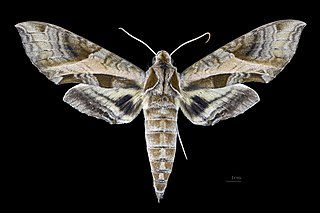
Eumorpha megaeacus is a moth of the family Sphingidae.
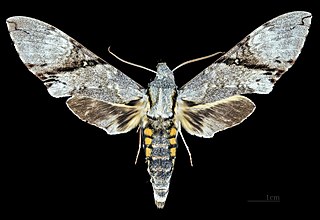
Manduca lefeburii is a moth of the family Sphingidae.
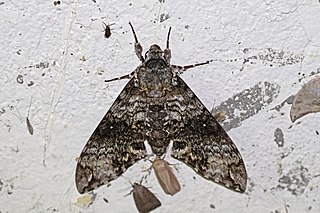
Manduca schausi is a moth of the family Sphingidae. It is found from Mexico, Guatemala, Nicaragua and Costa Rica to Brazil, Argentina and Bolivia.
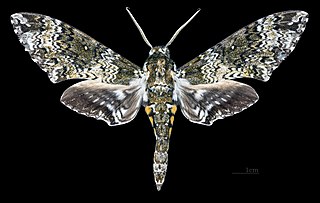
Manduca sesquiplex is a moth of the family Sphingidae. It is known from Mexico, Costa Rica and Nicaragua.























